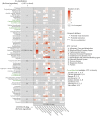Detecting drug-drug interactions between therapies for COVID-19 and concomitant medications through the FDA adverse event reporting system
- PMID: 35935872
- PMCID: PMC9353301
- DOI: 10.3389/fphar.2022.938552
Detecting drug-drug interactions between therapies for COVID-19 and concomitant medications through the FDA adverse event reporting system
Abstract
Background: COVID-19 patients with underlying medical conditions are vulnerable to drug-drug interactions (DDI) due to the use of multiple medications. We conducted a discovery-driven data analysis to identify potential DDIs and associated adverse events (AEs) in COVID-19 patients from the FDA Adverse Event Reporting System (FAERS), a source of post-market drug safety. Materials and Methods: We investigated 18,589 COVID-19 AEs reported in the FAERS database between 2020 and 2021. We applied multivariate logistic regression to account for potential confounding factors, including age, gender, and the number of unique drug exposures. The significance of the DDIs was determined using both additive and multiplicative measures of interaction. We compared our findings with the Liverpool database and conducted a Monte Carlo simulation to validate the identified DDIs. Results: Out of 11,337 COVID-19 drug-Co-medication-AE combinations investigated, our methods identified 424 signals statistically significant, covering 176 drug-drug pairs, composed of 13 COVID-19 drugs and 60 co-medications. Out of the 176 drug-drug pairs, 20 were found to exist in the Liverpool database. The empirical p-value obtained based on 1,000 Monte Carlo simulations was less than 0.001. Remdesivir was discovered to interact with the largest number of concomitant drugs (41). Hydroxychloroquine was detected to be associated with most AEs (39). Furthermore, we identified 323 gender- and 254 age-specific DDI signals. Conclusion: The results, particularly those not found in the Liverpool database, suggest a subsequent need for further pharmacoepidemiology and/or pharmacology studies.
Keywords: COVID-19; FAERS; additive interaction; discovery-driven; drug-drug interactions; hypothesis generation; logistic regresion; multiplicative interaction.
Copyright © 2022 Jeong, Nelson, Su, Malin, Li and Chen.
Conflict of interest statement
The authors declare that the research was conducted in the absence of any commercial or financial relationships that could be construed as a potential conflict of interest.
Figures





Similar articles
-
Detecting Drug-Drug Interactions in COVID-19 Patients.Stud Health Technol Inform. 2022 Jun 6;290:330-334. doi: 10.3233/SHTI220090. Stud Health Technol Inform. 2022. PMID: 35673029 Free PMC article.
-
Potential clinically significant drug-drug interactions of hydroxychloroquine used in the treatment of COVID-19.Int J Clin Pract. 2021 Nov;75(11):e14710. doi: 10.1111/ijcp.14710. Epub 2021 Aug 16. Int J Clin Pract. 2021. PMID: 34370370 Free PMC article.
-
Safety of triazole antifungals: a pharmacovigilance study from 2004 to 2021 based on FAERS.Ther Adv Drug Saf. 2022 Dec 16;13:20420986221143266. doi: 10.1177/20420986221143266. eCollection 2022. Ther Adv Drug Saf. 2022. PMID: 36545565 Free PMC article.
-
Analysis of Spontaneous Postmarket Case Reports Submitted to the FDA Regarding Thromboembolic Adverse Events and JAK Inhibitors.Drug Saf. 2018 Apr;41(4):357-361. doi: 10.1007/s40264-017-0622-2. Drug Saf. 2018. PMID: 29196988 Review.
-
Review of Statistical Methodologies for Detecting Drug-Drug Interactions Using Spontaneous Reporting Systems.Front Pharmacol. 2019 Nov 8;10:1319. doi: 10.3389/fphar.2019.01319. eCollection 2019. Front Pharmacol. 2019. PMID: 31780939 Free PMC article. Review.
Cited by
-
Adverse Event Profiles of Antiseizure Medications and the Impact of Coadministration on Drug Tolerability in Adults with Epilepsy.CNS Drugs. 2023 Jun;37(6):531-544. doi: 10.1007/s40263-023-01013-8. Epub 2023 Jun 4. CNS Drugs. 2023. PMID: 37271775 Free PMC article.
-
Drug-Drug Interactions among Patients Hospitalized with COVID-19 in Greece.J Clin Med. 2022 Dec 2;11(23):7172. doi: 10.3390/jcm11237172. J Clin Med. 2022. PMID: 36498745 Free PMC article.
-
The therapeutic landscape for COVID-19 and post-COVID-19 medications from genetic profiling of the Vietnamese population and a predictive model of drug-drug interaction for comorbid COVID-19 patients.Heliyon. 2024 Mar 5;10(6):e27043. doi: 10.1016/j.heliyon.2024.e27043. eCollection 2024 Mar 30. Heliyon. 2024. PMID: 38509882 Free PMC article.
-
Evaluation of the Drug-Drug Interaction Potential of Ensitrelvir Fumaric Acid with Cytochrome P450 3A Substrates in Healthy Japanese Adults.Clin Drug Investig. 2023 May;43(5):335-346. doi: 10.1007/s40261-023-01265-8. Epub 2023 May 12. Clin Drug Investig. 2023. PMID: 37171749 Free PMC article. Clinical Trial.
References
-
- Agency E. M. (2020). COVID‐19: Reminder of risk of serious side effects with chloroquine and hydroxychloroquine. European: European Medicines Agency.
-
- Arshad U., Pertinez H., Box H., Tatham L., Rajoli R. K. R., Curley P., et al. (2020). Prioritization of anti-SARS-cov-2 drug repurposing opportunities based on plasma and target site concentrations derived from their established human pharmacokinetics. Clin. Pharmacol. Ther. 108 (4), 775–790. 10.1002/cpt.1909 - DOI - PMC - PubMed
Grants and funding
LinkOut - more resources
Full Text Sources
Other Literature Sources

